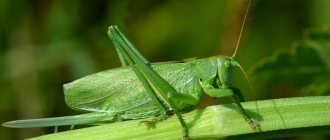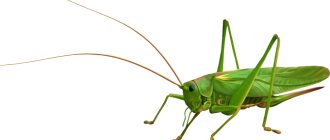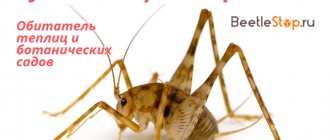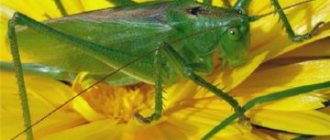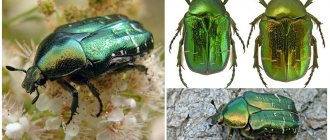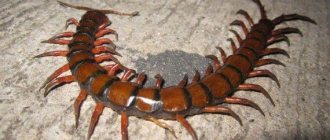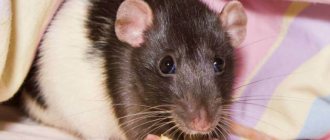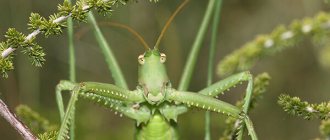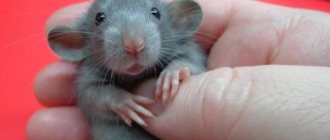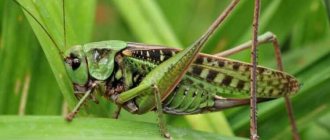Mega grasshoppers
During the day, these insects usually hide in the foliage, under the hanging long branches of ferns, palms or other trees. And at night they leave their homes in search of food and new shelter. They usually move through trees or on the ground.
Adults do not live long, during which time they mate several times and leave offspring. Females lay many eggs at once in the soft forest soil, from which new mega-grasshoppers soon hatch.
Fact! This subspecies was originally widespread in Northland, Auckland and Big Barrier Island. But destruction of the natural habitat and exotic predators led to the extinction of the Hueta grasshoppers. Fortunately (or unfortunately), the population has survived on Little Barrier. Biologists also regularly resettle artificially bred individuals on other islands of New Zealand.
Lifestyle and habitat
Although grasshoppers take root well in alpine meadows, in the tropics and in the tundra, they are still unable to withstand the climate of very arid deserts and arctic cold. They feel great in the expanse of the steppe, in forest glades and forest edges, in wheat and potato fields, and in thickets of bushes.
Such creatures conduct their life activities on the surface. Hiding underground, in secluded places under fallen branches and stumps, in tree hollows and holes is not for them. Usually they simply move along grass and other plants, hiding from the hot sun and bad weather under their leaves.
They usually rest during the day and go out to hunt at night. And it is at this time that it is possible to hear their chirping. As mentioned earlier, such sounds are produced by males. This way they can attract their friends for mating, and also inform their rivals that this territory is protected because it is already occupied.
grasshopper jump
a green insect in nature that looks like a grasshopper . These are locusts. True, it can also have brown, gray and yellow, but also a camouflage color, that is, to match the color of the environment. And at a superficial glance, it can be almost impossible to distinguish between these two insects.
However, there are significant differences in their behavior. Locusts live in swarms. And such countless hordes are sometimes so huge that they simply destroy entire fields of crops with fantastic speed. Grasshoppers, as a rule, are solitary creatures. And yet, the locust does not jump, but it flies well, and its legs are shorter.
The fight for the survival of the species
Now these huge grasshoppers are in danger of extinction, so biologists are doing everything possible to prevent this. For example, staff at the Butterfly Creek Project in South Auckland successfully conducted a Weta breeding experiment. No one had ever tried to breed these insects in captivity on such a scale, but immediately after their success, many enthusiasts followed suit.
The project started in 2010. 18 adult Weta were taken from Little Barrier Island, and then, after artificial selection, 25 new grasshoppers were “evicted” to the Tiritiri Matangi Nature Reserve Island. And the same amount - to another “pure” island-reserve Motuora.
In 2012, the Auckland Nature Reserve joined the species conservation project. His staff collected 12 grasshoppers from Little Barrier Island to house and hatch at the sanctuary.
Within a year, more than a hundred Ueta cubs were hatched in the reserve; they were placed in specially built enclosures. And they even had to hire additional staff to help grow and breed the increasing population.
There were so many of them that there were no longer enough separate enclosures. Therefore, the entomogs slightly changed the breeding program and began raising Weta in groups in large cages. Both methods have shown their success.
Description and features
The grasshopper is an insect found almost everywhere. It is so hardy and unpretentious to environmental conditions that it can successfully take root in almost any corner of the vast world, with the exception of areas of the planet covered with eternal snow and bound by ice all year round. This insect is found on plains and highlands, hiding in green meadow grass; it is an inhabitant of humid, hot jungles and even arid deserts.
This creature belongs to the order Orthoptera and has many interesting structural features. They allow such representatives of the insect world to successfully survive, spreading across countries and continents.
The grasshopper has three pairs of legs. Moreover, the front four limbs are used for walking, and, not surprisingly, the ears of the insect are placed on them. And the muscular hind legs, capable of pushing off any surface with enormous force, enable such a creature to make impressive jumps.
In this case, the grasshopper rises very high and moves over considerable distances, twenty times greater than its own size. In addition, some varieties of such insects have wings, and two pairs: front and rear. With their help, the grasshopper is also able to mix, although not very far.
The impressive antennae, which are often longer than the body of these small creatures, serve as their organs of touch. The body of these insects itself has three sections. The first of them is a large head, on which large faceted, oval-shaped eyes are clearly visible. The other two parts are the chest and abdomen.
Insects are known for their ability to make interesting noises - chirping. Moreover, the sounds of a grasshopper are rightfully considered unique, differing in volume, timbre and melody depending on the species.
And representatives of each of them can boast of their own unique sound. The role of the “tool” is played by a special membrane located on the left elytra. It has a thick vein with teeth - this is a kind of bow.
And the membrane on the right elytra functions as a resonator. Such natural devices produce unique melodies when vibrating. In most species of such insects, only males are endowed with “musical” abilities. But there are also types of grasshoppers in which the females can also chirp.
As already mentioned, grasshoppers listen with their feet, since their organs designed to capture sound waves are located on the front legs of these creatures. More precisely, the eardrums are located on the shins.
In some varieties they are open, but some species are equipped with special caps that hide them. The hearing aid itself has very sensitive cells and nerve endings.
Amazing facts
Female Weta grasshoppers are heavier and larger than males. On average, the weight of females can reach up to 35 grams. This is even more than the average sparrow weighs!
Puberty in both females and males occurs at approximately 14-24 months. They begin to mate 1-2 months after maturity. During one mating, the female lays 10-300 eggs.
The subspecies' favorite diet is fresh leaves from local plants. For example, they love to eat the foliage of karaka, karama, mamanga, masho and koekohe. Until the moment of “coming of age,” each grasshopper goes through 11 periods of maturation. This means that he loses his external exoskeleton 11 times and acquires a new one.
Structural features of the wetapunga
Wetapunga, as the Maori Indians called their most terrible deity. Therefore, the name of the grasshopper is translated into Russian as “the deity of freaks.” But, despite the unattractive name, there is nothing particularly terrible in their structure. These are large grasshoppers, whose dimensions reach 10 centimeters and weigh 70 grams. In terms of mass, grasshoppers can be compared to a large mouse or two sparrows, that’s how big they are. Wetapunga, although considered an insect, does not have wings and never has. Due to their size, weeta do not even jump like their small cousins, grasshoppers; due to their large weight, they simply move slowly along surfaces.
Weta (wetapunga) . Photo credit: Steve Attwood.
According to scientists, this species has not undergone any special evolution over millions of years. Wetapunga looked about the same in the age of dinosaurs. These are three pairs of paws. The most powerful ones are the rear ones; they are also covered with thick spikes to fight off enemies. If with their help it is not possible to get rid of the enemy, the grasshopper falls and pretends to be dead.
This organ looks menacing, but it is just the ovipositor of a wetapunga. Photo credit: Tony Jewell.
There is another spike at the back of the abdomen, but it is not intended for protection. It is called an ovipositor. This is a kind of shovel. With its help, the female digs a hole, lays eggs there, and then buries it all. Wetapunga also necessarily has long antennae, they are longer than the body. It is at the same time an organ of touch and charm, and a kind of transmitter of danger. If you touch the antennae of one, the other crickets nearby will become worried. With the help of processes, insects also explore the area, marking the smallest details and characteristics.
Estimate the size of the insect! Photo by: Martin Sanders.
All weeta have large, protruding black eyes. New Zealand grasshoppers are nocturnal creatures, hence this feature. Large jaw, occupies approximately half of the head. Crickets are herbivores; they eat mainly fruits, flowers, leaves, and grass. The jaws work on the principle of pincers; they grab, clamp and drag food into the mouth, which is processed by small but sharp teeth. Thus, a wetapunga can easily grab a person’s finger, bite and not let go for a long time, holding it with its powerful pincers. But grasshoppers bite and scratch only when they sense danger. Otherwise they are quite harmless.
Wetapunga spp. Deinacrida fallai. Photo by: Dylan van Winkel.
LiveInternetLiveInternet
Quote from nomad1962
Read in full In your quotation book or community!
What is weta?!
Giant weta are very large orthoptera insects belonging to the species Ueta, genus Deinacrida , family Anostostomatidae .
They live exclusively on the territory of New Zealand and are representatives of the so-called “island gigantism”, associated with the absence of small mammals in their habitat, the place of which was taken by the weta.
There are 11 known species of giant weta, most of which are much larger than other representatives not only of their species, but also of all insects on planet Earth known to science. The largest specimens can reach up to 10 cm in height (excluding the length of the limbs and antennae) and weigh 35-38 grams.
In 1999, a female weta was discovered that weighed 70 grams
(for comparison, a sparrow weighs 40 g) and is recognized as the largest and heaviest insect in the world, but this is an isolated case and such giants have never been seen by people.
Giant wetas reach sexual maturity at the age of 1.5 years and begin to actively reproduce. Soon after the female lays eggs (~200-300), she dies.
This type of insect has its hind legs “strewn” with sharp thorns, which the weta use to protect themselves from predators. In case of danger, the insect forcefully throws out its hind limbs in the direction of the source of the threat.
Almost all of them are wingless. Outwardly, they somewhat resemble a large brown grasshopper, but the hind legs are enlarged and covered with large spines. During defense, the insect forcefully throws them in front of itself and tries to injure the attacker.
But what is the reason for the development of gigantism among these insects? These “living fossils” (yes, they have very ancient origins) ended up in the New Zealand area, even before it became an isolated archipelago. At that time, there were no small mammals there - the main enemies of the weta, and they occupied their niche.
Hueta are perfectly adapted to living in any habitat, be it forest, field, caves, land or city parks. They are nocturnal. Most of these giants are predators, but the giant weta feeds on lichens, leaves, flowers and fruits
These insects bring considerable benefits to the development of the flora of New Zealand - they take an active part in distributing the seeds of local plants, feeding on their fruits.
But now there is a decline in the number of these insects. The main reason for this disgrace is the destruction of the giant weta by small mammals and rodents brought to these islands by humans.
masterok
Lots of questions
Indeed, I would like at least some specific words from experts about whether this fact actually took place. There is only an old photograph in which the largest grasshopper (photo attached) hangs lifelessly with its antennae down, its hind legs (although in relation to the photograph one should say antennae and paws) are doubtfully clamped by the frail hand of a brave hunter. If this fact took place, then where was the public looking? Did the Red Book appear after this incident? There are more questions than answers. The photo looks like an obvious hoax - Americans are generally known forgers. Every criticism is valid. Indeed, where is the shadow of the grasshopper? Why is the posture of a successful hunter so relaxed, because the load is considerable? Someone even pointed out the fact that in 1937 “baseball caps” were not worn. As for the size, there are clear facts that they do not correspond to the life of this type of insect.
Interesting facts about Wetapunga
Weta (ueta) is an insect resistant to harsh climatic conditions; in the scientific literature there is information that under the influence of severe frosts, wetapunga remains viable for a long time. This property is due to the presence of special protein substances in the blood that prevent the insect’s blood from freezing. While all organs stop working, the blood continues to perform its metabolic function. When the temperature rises again to an acceptable level, the animal will revive without serious consequences. Thanks to this physiological feature, giant grasshoppers survived the Ice Age and survived to this day.
Efremov Alexander Vladimirovich, specially for Natureworld.ru: “Insects” Author of the first photo: Brendon & Keryn Doran.
